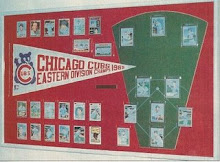The son of polish immigrants, bi-lingual, raised on a potato farm, star basketball player (yes basketball, attending Notre Dame for a short while on a basketball scholarship), then signing with the Boston Red Sox in 1959 to embark on his historic baseball career.
Historic it was as pressure mounted for Yaz to supplant the great Ted Williams in left field and have to deal with the famed "Green Monster" at Fenway. After a mediocre rookie campaign, batting only .266 in 1961, Yaz made it his mission to improve and improve he did.
 (this is one of the first cards that I will upgrade after I complete the set, note the crease bottom right)
(this is one of the first cards that I will upgrade after I complete the set, note the crease bottom right)From winning he batting title in 1963 with a .321 average, leading the league in doubles and finishing sixth in the MVP voting that year to his Triple Crown {.326 BA, 44 HR, 121 RBIS} and MVP year of 1967, to his first ballot hall of fame induction in 1989 appearing on 94.6 % of ballots, Yaz certainly did not disappoint any.
With so many remarkable moments in his career and career numbers in the top ten in many offensive categories (except homeruns) Yaz spent his entire 23 year career in a Boston uniform (his #8 was retired in 1989 as well). That feat deserves repeating; Yaztrzemski played twenty-three years in the same city, no other player (besides Brooks Robinson of the Orioles) has had a longer career with one team - ever. A record I do not foresee being challenged in today's marketplace.
Yaz was the first player in the AL ever to be a member of the 3000 hit and 400 homerun club, eighteen (18) times an all-star, seven (7) gold gloves and receiving votes for the MVP in 14 different years.
 As noted on the back of his 1970's card, Yaz was the only "regular" player to hit .300 or higher in "the year of the pitcher" 1968, winning his third batting title.
As noted on the back of his 1970's card, Yaz was the only "regular" player to hit .300 or higher in "the year of the pitcher" 1968, winning his third batting title.Known for holding his unique batting stance, keeping his bat unusually high, giving him a long and powerful arc with added power at the plate, Yaz was able to hit 452 career HR's, with 1844 RBI's, 1157 extra base hits (including 646 doubles) to go along with 1845 walks (ranking 6th all time).
Carl Yastrzemski . . . Topps 1970 card # 10 . . . Boston Red Sock . . . Hall of Famer . . .
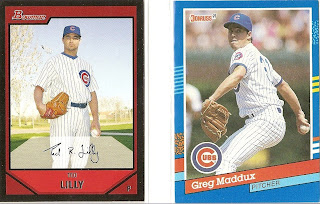.jpg) Yesterday's spring training game against the Indians (Cubs lost 7-5) where Lilly gave up two home runs to DeRosa (almost had a third if not for that tall wall) it was mentioned that Lilly was "setting up" DeRosa for later on in the season as Maddux had done throughout his career to perfection.
Yesterday's spring training game against the Indians (Cubs lost 7-5) where Lilly gave up two home runs to DeRosa (almost had a third if not for that tall wall) it was mentioned that Lilly was "setting up" DeRosa for later on in the season as Maddux had done throughout his career to perfection.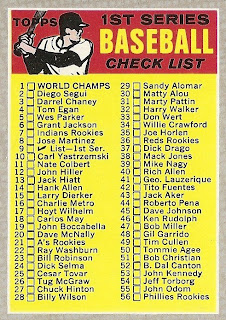 The only one interesting note is the red/yellow header on the front with the players names printed in black ink whereas the backs are the "normal" blue ink and yellow background.
The only one interesting note is the red/yellow header on the front with the players names printed in black ink whereas the backs are the "normal" blue ink and yellow background. 

 The blog started on February 5, 2009, this is the opening photo and the first sentence reads: "Welcome to a most unusual website. It is for lovers of pure baseball . . . "
The blog started on February 5, 2009, this is the opening photo and the first sentence reads: "Welcome to a most unusual website. It is for lovers of pure baseball . . . " While Martinez did have a reasonably sound year in 1969, helping out at second base for the injured Bill Mazeroski; hitting .268 in 77 games. He played in only 19 games in 1970 batting .050 and then baseball was in his past.
While Martinez did have a reasonably sound year in 1969, helping out at second base for the injured Bill Mazeroski; hitting .268 in 77 games. He played in only 19 games in 1970 batting .050 and then baseball was in his past.
 I also don't know that guy standing at third. At first glance it looked like Ron Cey, floppy hair over the collar and a bit stocky, but in the seventies with the Dodgers, Cey wore uniform # 10 ! (though he did wear # 11 as a Cub, but not until the early eighties). So at second glance it might be a Chicago Cub, but Don Kessinger wore # 11 during those days and that is not Kessinger (he is tall and thin).
I also don't know that guy standing at third. At first glance it looked like Ron Cey, floppy hair over the collar and a bit stocky, but in the seventies with the Dodgers, Cey wore uniform # 10 ! (though he did wear # 11 as a Cub, but not until the early eighties). So at second glance it might be a Chicago Cub, but Don Kessinger wore # 11 during those days and that is not Kessinger (he is tall and thin). He actually sent me nine (9) Topps 1970 cards, all of which I needed/wanted
He actually sent me nine (9) Topps 1970 cards, all of which I needed/wanted  I dont want to share too many of these but I had to mention this Cubbie, Al Spangler # 714 (a member of the much cherished Cubs of 1969). While Paul knew I had this card, he also knows I am trying to put together a second set of the 1970 Cubs team as my first set is framed behind glass (note my first post and center piece of my collection).
I dont want to share too many of these but I had to mention this Cubbie, Al Spangler # 714 (a member of the much cherished Cubs of 1969). While Paul knew I had this card, he also knows I am trying to put together a second set of the 1970 Cubs team as my first set is framed behind glass (note my first post and center piece of my collection). 1969 Gary Holman # 361: after his .294 BA in 1968 he deserved this gold trophy, however it must have gone to his head as Holman appeared in just 41 games in 1969 and called it a career.
1969 Gary Holman # 361: after his .294 BA in 1968 he deserved this gold trophy, however it must have gone to his head as Holman appeared in just 41 games in 1969 and called it a career. 1969 Dave Nelson # 579: a 10 year 4 team "journey man" and one-time all-star (1973 in Texas)
1969 Dave Nelson # 579: a 10 year 4 team "journey man" and one-time all-star (1973 in Texas) 1969 Ken Boswell # 402: a "hated" Met ! That's all !
1969 Ken Boswell # 402: a "hated" Met ! That's all ! 1975 Arnold Ray "Bake" McBride # 174: the NL ROY in 1974 did not disappoint; a career .299 BA, one time all-star (1976) and one World Series ring (1980 Phillie). Love those sideburns !
1975 Arnold Ray "Bake" McBride # 174: the NL ROY in 1974 did not disappoint; a career .299 BA, one time all-star (1976) and one World Series ring (1980 Phillie). Love those sideburns ! 1975 Frank Tanana # 16: as Chris Berman dubbed him Frank Tanana "Daiquiri", had a 21 year career, 3X All-star (1976, 77, 78) and a 100+ mph fastball. His career numbers are impressive, 240-236 WL, 2773 strikeouts and over 4000 innings pitched.
1975 Frank Tanana # 16: as Chris Berman dubbed him Frank Tanana "Daiquiri", had a 21 year career, 3X All-star (1976, 77, 78) and a 100+ mph fastball. His career numbers are impressive, 240-236 WL, 2773 strikeouts and over 4000 innings pitched.

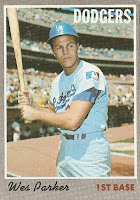 Parker had a career batting average of .267 had 1110 hits, 64 HR's while driving in 470 runs. His best offensive year was in 1970 playing in a league leading 161 games, batting .319 with 111 RBI's and 47 doubles; coming in 5th in MVP voting that year as well. Defensively, Parker was phenomenal; not only those six gold gloves but he had a career fielding percentage of .996 ! In 2007, Parker was named to the Major League Baseball All-Time Gold Glove Team, being the only eligible member of the team who is not in the Hall of Fame.
Parker had a career batting average of .267 had 1110 hits, 64 HR's while driving in 470 runs. His best offensive year was in 1970 playing in a league leading 161 games, batting .319 with 111 RBI's and 47 doubles; coming in 5th in MVP voting that year as well. Defensively, Parker was phenomenal; not only those six gold gloves but he had a career fielding percentage of .996 ! In 2007, Parker was named to the Major League Baseball All-Time Gold Glove Team, being the only eligible member of the team who is not in the Hall of Fame.
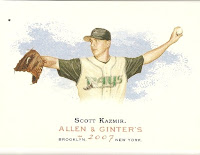 I like the 2007 A & G !
I like the 2007 A & G ! Is this a homerun swing or . . . is that ball speeding right over Crawford bat for strike three ? Nice Devil Ray card, 2006 Fleer Ultra # 50.
Is this a homerun swing or . . . is that ball speeding right over Crawford bat for strike three ? Nice Devil Ray card, 2006 Fleer Ultra # 50.

 Some of my favorites are:
Some of my favorites are:
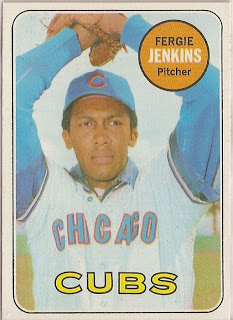
 This has been a long time waiting for Jenkins but having these two super stars in Cubs history share this honor is fitting. The # 31 will now fly proudly on the outfield pole along side; #10, #14, # 23 and # 26 !
This has been a long time waiting for Jenkins but having these two super stars in Cubs history share this honor is fitting. The # 31 will now fly proudly on the outfield pole along side; #10, #14, # 23 and # 26 !

 Egan had a career BA of only .200, hit 22 HR's (ten of which were in 1971, when he appeared in the most games of his career in one year at 85). Egan struck out 336 times in his career, almost one per game (not a very impressive statistic at all). At 6'4" and around 220 pounds, he was a "giant" in those days. Maybe he should have stayed with football as he was a high school all-american running back.
Egan had a career BA of only .200, hit 22 HR's (ten of which were in 1971, when he appeared in the most games of his career in one year at 85). Egan struck out 336 times in his career, almost one per game (not a very impressive statistic at all). At 6'4" and around 220 pounds, he was a "giant" in those days. Maybe he should have stayed with football as he was a high school all-american running back.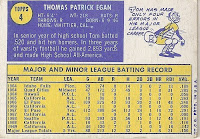

 It was in college that Heaton was known to throw fire. The two-time All American won 42 games as a Hurricane and had 23 strikeouts in one game against Indiana State on March 10, 1981. He has had his #26 retired by the UM baseball team and elected to the UM Hall of Fame in 1992. With Coach Ron Fraser running the team like a "minor league show", attendance at Mark Light Stadium on the campus of UM was packed every night, especially when "the Heater" was on the mound.
It was in college that Heaton was known to throw fire. The two-time All American won 42 games as a Hurricane and had 23 strikeouts in one game against Indiana State on March 10, 1981. He has had his #26 retired by the UM baseball team and elected to the UM Hall of Fame in 1992. With Coach Ron Fraser running the team like a "minor league show", attendance at Mark Light Stadium on the campus of UM was packed every night, especially when "the Heater" was on the mound. This 1970 card # 3 is his official rookie card and Chaney did earn a World Series ring with the "Big Red " Machine of 1975 as he was the functional off the bench utility guy for Dave Concepcion. Interesting to note is that Chaney had more career triples (17) than homeruns (14). That is about the most "exciting" thing I could find about Chaney.
This 1970 card # 3 is his official rookie card and Chaney did earn a World Series ring with the "Big Red " Machine of 1975 as he was the functional off the bench utility guy for Dave Concepcion. Interesting to note is that Chaney had more career triples (17) than homeruns (14). That is about the most "exciting" thing I could find about Chaney.
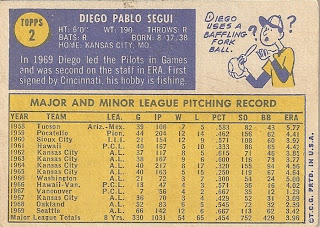 Here is a good example of the backs of the 1970 cards: as I said in my pre-view post, I like the color combination of blue and yellow - reminds me of outdoor day basball (the sky and sunshine). The cartoon image in the upper right was sometimes "humorous" (haha fork in the ball) and sometimes hobby related as we will see in some later posts.
Here is a good example of the backs of the 1970 cards: as I said in my pre-view post, I like the color combination of blue and yellow - reminds me of outdoor day basball (the sky and sunshine). The cartoon image in the upper right was sometimes "humorous" (haha fork in the ball) and sometimes hobby related as we will see in some later posts.








 This 1984 Topps card # 508 shows Hall running . . . probably from the law . . . take the cap off and his mugshot is right there too.
This 1984 Topps card # 508 shows Hall running . . . probably from the law . . . take the cap off and his mugshot is right there too.

